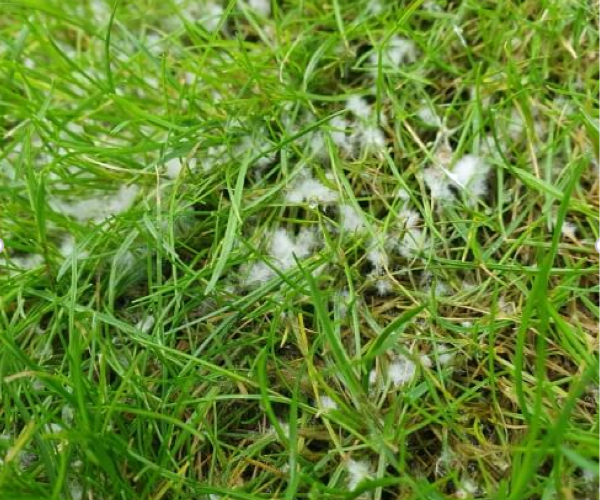- Lawn Turf
- Artificial
- Soil
- Timber
- Composite Decking
- Paving & Stone
Get In Touch With Our Experts Today!
Give us a Call! - Seed & Fertiliser
- Dressing
- Bark

August 15, 2023 Turf Tips
If you have been dealing with a lawn that looks a little worse for wear despite your best efforts, it could be due to lawn disease. Lawn fungi and diseases can cause significant damage to your grass if left untreated.
Common causes include fungi, bacteria and viruses that attack the roots of your grass and weaken it over time. In this article, we focus on how you can recognise these issues early on, as well as the causes and treatments. With the right approach, you can nurture a lush green lawn once more.
Some of the most common lawn diseases in the UK include red thread, fairy ring, snow mould, lawn rust and dollar spot. It can be difficult to identify exactly which disease may be hindering the health of your lawn, as they can cause similar symptoms, but here are just a few key indicators to keep in mind:
During humid weather with extended dry spells, red thread can appear in the form of small straw-coloured patches of grass. Red thread will also likely have a noticeable pinkish hue overall and may cause the tips of the grass blades to twist or bend.
The most effective treatment for red thread is applying a nitrogen-rich fertiliser and ensuring the soil is kept moist. Additionally, mowing your grass more often can help reduce the spread of red thread by removing infected blades of grass before they can spread the fungus spores further across your lawn. Also, watering deeply but infrequently will encourage deeper root growth which helps build resistance against diseases like red thread.
This form can be identified by patches of darker green grass, light-brown discolouration or mushroom/toadstool rings in the lawn, usually growing in diameter as it spreads from the centre. The fungus feeding on the roots of your lawn can cause it to die and leaves dead patches behind.
The best way to treat fairy ring in your lawn is to aerate the soil, which will help break up the fungal growth. Additionally, you should apply a fungicide specifically designed for treating fairy ring and water deeply but infrequently so that the roots of your grass can reach down further into the soil. You may also need to top dress with a fresh layer of high-quality compost or sand to fill in any dead patches caused by the fungus and overseed these areas with new grass seed.
As the name suggests, snow mould manifests as a thin layer of white, fluffy patches on the lawn, primarily observed during the colder months. This unsightly problem is typically a result of cold and damp weather, but it can also be triggered by inadequate drainage due to excessive thatch build-up in the lawn.
To effectively combat snow mould and restore the health of your lawn, it’s essential to aerate the lawn, promoting better air circulation and encouraging the grass to recover from the damage. A nitrogen-rich fertiliser will also help aid recovery, promoting new growth and enhancing the lawn’s overall resilience.
Insufficient soil nutrition and excessive leaf cutting frequently contribute to lawn rust. Rust can be easily transmitted through foot traffic by both animals and humans, as well as through common gardening tools.
Maintaining your lawn in excellent condition is vital to avoiding the risk of lawn rust. Ensure you apply a high-nitrogen quick-releasing fertiliser to help stimulate grass growth and mow your lawn regularly. Applying a fungicide helps prevent the disease from spreading further and will help reduce the risk of rust developing.
These will appear as small, circular dead grass spots likely to occur in warm and humid weather conditions. The best way to treat this type of lawn disease is like lawn rust: applying a high-nitrogen fertiliser and regularly mowing. You should also aerate the soil and use a fungicide if the fungus is severe.
Although there are treatments available for lawn diseases and fungal issues, the best way to prevent them in the first place is to make sure that your lawn’s health is maintained correctly on an ongoing basis. This includes regular:
Mowing: Regular mowing plays a vital role in stimulating the lateral growth of the grass while minimising stress on the turf. By removing a small portion of the grass blade during each mowing session, the lawn remains healthy and vigorous.
Watering: Water your lawn deeply but infrequently to encourage deep root growth. Early morning watering is ideal to minimise water loss due to evaporation and to prevent prolonged periods of moisture that can attract fungal growth.
Aeration: Regularly aerate your lawn to improve drainage and increase air circulation at the root level. This helps to break up thatch, which can contribute to lawn diseases if left unchecked.
Fertilisation: Regularly fertilising your lawn is essential to provide the necessary nutrients for healthy growth and improved resistance to stress, pests, and diseases for a lush green appearance.
Weed Control: Be sure to keep your lawn free from weeds, as they can spread diseases and weaken the roots of your grass. Regularly spot-treat weeds with an appropriate herbicide to keep them under control and promote the health and vitality of the grass.
You can discover top-quality turf care and products here at George Davies Turf, a trusted family-owned independent business with over 30 years of experience. We source our turf from the finest turf farms in the country, ensuring premium quality for our customers. Whether you’re a seasoned turf enthusiast or a beginner seeking advice, our knowledgeable professionals are here to guide you in nurturing your lawn. Call us today on 01234 603 193 or email [email protected], and we’d be delighted to help.